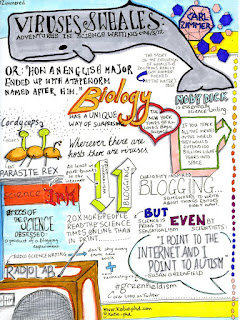To Write or Not to Write that is the Question

One question we ask teacher candidates for entrance in our program is “Do you think it is possible to make a student participate?” This question brings up the notion of “free will” and the role of the teacher to inspire learning rather than demand student participation.
Participation is after all a choice and it gives students power in the classroom. It is possible that students who do not participate, especially with tasks that are within their reach (ZPD) are doing so for power because in class and perhaps outside your classroom they feel powerless.
So how do teachers empower students to actively participate?
Give student a Choice and a Voice in how they learn information.
 I recently visited my student intern who was lecturing on the topic of Marine Invertebrates. The information she was sharing was quiet interesting. She included videos to provide students with visuals and asked questions to help guide their thinking, but despite her attempts to engage all students a few had “checked out” and were not actively taking notes or responding to questions.
I recently visited my student intern who was lecturing on the topic of Marine Invertebrates. The information she was sharing was quiet interesting. She included videos to provide students with visuals and asked questions to help guide their thinking, but despite her attempts to engage all students a few had “checked out” and were not actively taking notes or responding to questions.
I noticed they were actively doodling and drawing illustrations throughout the lecture.
During our debriefing I recommended she try sketchnotes with her students and give them a choice in how they take notes by introducing a variety of approaches to note-taking strategies throughout the year. This is especially important for secondary students as note-taking is the primary means of learning new information, and will help transfer new facts from short term to long-term memory. Students who don’t take notes during a lecture might as well not show up to class. 
Sketchnotes support students in making new information memorable and this is critical for all students who are preparing for careers and college beyond high school.
As I returned to my student intern’s classroom a few weeks after our meeting she was excited to share the increased participation of all students by using sketchnotes.
Notetaking without Sketchnotes:
After Using Sketchnotes:
Here are a few tips for using Sketchnotes:
- Drawings and symbols to represent associations for new ideas. Associations will help with recall and to organize new ideas with already existing schemas
- Color and Shape Size to emphasize key points and salient information that is important to recall and draw your attention.
- Go Beyond Linear Writing and experiment with format, and flow of notes to create a unique space to express your thoughts and organize ideas.
- Use Arrows and bullets to capture ideas, connect points and synthesize information
And Finally SHARE, SHARE, SHARE. We learn so much from each other and this is especially important for kids to learn from their grade-alike peers as they can make connections that are only meaningful to their generation, “Dab” unless your Betty White.
.
via GIPHY
What innovative ways are you making connections for students in your classroom? Share your ideas with us or tell us how you are using Sketchnotes in your instruction?





